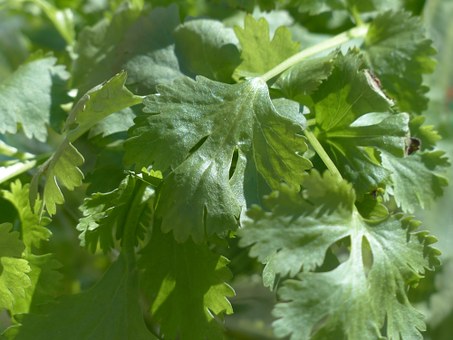
Assessment of Vitamin and Carotenoid Concentrations of Emerging Food Products: Edible Microgreens
By PubMed
Posted by Admin on Sunday, August, 19 2012 and filed under Research
Key topics: Cilantro • Dhaniya

Coriander (Coriandrum sativum), also known as cilantro, Chinese parsley or dhania, is an annual herb in the family Apiaceae. Coriander is native to regions spanning from southern Europe and North Africa to southwestern Asia.
Xiao Z, Lester GE, Luo Y, Wang Q. Assessment of vitamin and carotenoid concentrations of emerging food products: edible microgreens. 1. J Agric Food Chem. 2012 Aug 8;60(31):7644-51. Epub 2012 Jul 30.
Microgreens (seedlings of edible vegetables and herbs) have gained popularity as a new culinary trend over the past few years. Although small in size, microgreens can provide surprisingly intense flavors, vivid colors, and crisp textures and can be served as an edible garnish or a new salad ingredient. However, no scientific data are currently available on the nutritional content of microgreens. The present study was conducted to determine the concentrations of ascorbic acid, carotenoids, phylloquinone, and tocopherols in 25 commercially available microgreens. Results showed that different microgreens provided extremely varying amounts of vitamins and carotenoids. Total ascorbic acid contents ranged from 20.4 to147.0 mg per 100 g fresh weight (FW), while ?-carotene, lutein/zeaxanthin, and violaxanthin concentrations ranged from 0.6 to 12.1, 1.3 to 10.1, and 0.9 to 7.7 mg/100 g FW, respectively. Phylloquinone level varied from 0.6 to 4.1 ?g/g FW; meanwhile, ?-tocopherol and ?-tocopherol ranged from 4.9 to 87.4 and 3.0 to 39.4 mg/100 g FW, respectively. Among the 25 microgreens assayed, red cabbage, cilantro, garnet amaranth, and green daikon radish had the highest concentrations of ascorbic acids, carotenoids, phylloquinone, and tocopherols, respectively. In comparison with nutritional concentrations in mature leaves (USDA National Nutrient Database), the microgreen cotyledon leaves possessed higher nutritional densities. The phytonutrient data may provide a scientific basis for evaluating nutritional values of microgreens and contribute to food composition database. These data also may be used as a reference for health agencies' recommendations and consumers' choices of fresh vegetables.
Health, fitness and longevity
Based upon the principles of health
in the Qur'an and Prophetic Traditions.
HealthyMuslim.Com
There are two bounties in which
most people lose out: good health
and free time. Al-Bukhari.
The information on this site is provided for educational purposes only. It is not intended as a substitute for professional advice of any kind.